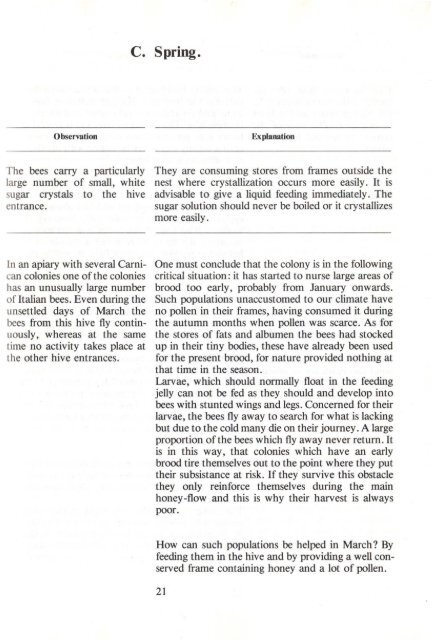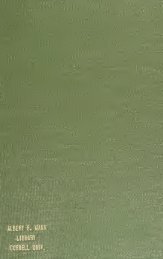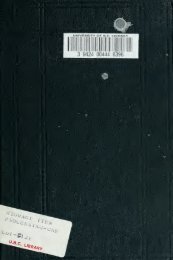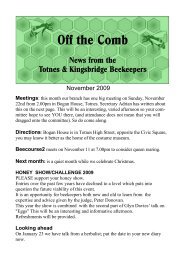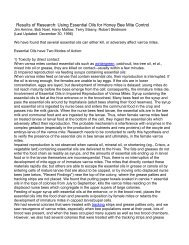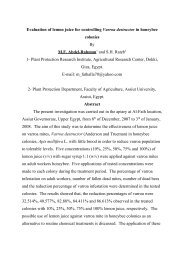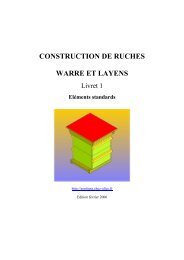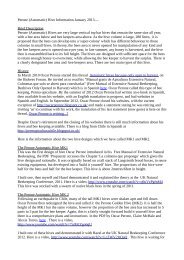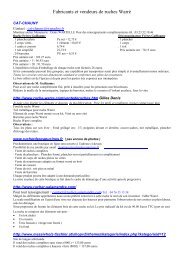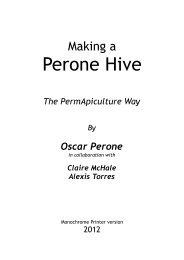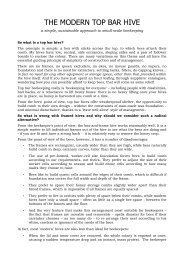Create successful ePaper yourself
Turn your PDF publications into a flip-book with our unique Google optimized e-Paper software.
c. Spring.<br />
Observation<br />
Explanation<br />
The bees carry a particularly<br />
large number of small, white<br />
sugar crystals to <strong>the</strong> hive<br />
entrance.<br />
They are consuming stores from frames outside <strong>the</strong><br />
nest where crystallization occurs more easily. It is<br />
advisable to give a liquid feeding immediately. The<br />
sugar solution should never be boiled or it crystallizes<br />
more easily.<br />
In an apiary with several Carnican<br />
colonies one of <strong>the</strong> colonies<br />
has an unusually large number<br />
of Italian bees. Even during <strong>the</strong><br />
unsettled days of March <strong>the</strong><br />
bees from this hive fly continuously,<br />
whereas at <strong>the</strong> same<br />
time no activity takes place at<br />
<strong>the</strong> o<strong>the</strong>r hive entrances.<br />
One must conclude that <strong>the</strong> colony is in <strong>the</strong> following<br />
critical situation: it has started to nurse large areas of<br />
brood too early, probably from January onwards.<br />
Such populations unaccustomed to our climate have<br />
no pollen in <strong>the</strong>ir frames, having consumed it during<br />
<strong>the</strong> autumn months when pollen was scarce. As for<br />
<strong>the</strong> stores of fats and albumen <strong>the</strong> bees had stocked<br />
up in <strong>the</strong>ir tiny bodies, <strong>the</strong>se have already been used<br />
for <strong>the</strong> present brood, for nature provided nothing at<br />
that time in <strong>the</strong> season.<br />
Larvae, which should normally float in <strong>the</strong> feeding<br />
jelly can not be fed as <strong>the</strong>y should and develop into<br />
bees with stunted wings and legs. Concerned for <strong>the</strong>ir<br />
larvae, <strong>the</strong> bees flyaway to search for what is lacking<br />
but due to <strong>the</strong> cold many die on <strong>the</strong>ir journey. A large<br />
proportion of <strong>the</strong> bees which flyaway never return. It<br />
is in this way, that colonies which have an early<br />
brood tire <strong>the</strong>mselves out to <strong>the</strong> point where <strong>the</strong>y put<br />
<strong>the</strong>ir subsistance at risk. If <strong>the</strong>y survive this obstacle<br />
<strong>the</strong>y only reinforce <strong>the</strong>mselves during <strong>the</strong> main<br />
honey-flow and this is why <strong>the</strong>ir harvest is always<br />
poor.<br />
How can such populations be helped in March? By<br />
feeding <strong>the</strong>m in <strong>the</strong> hive and by providing a well conserved<br />
frame containing honey and a lot of pollen.<br />
21


